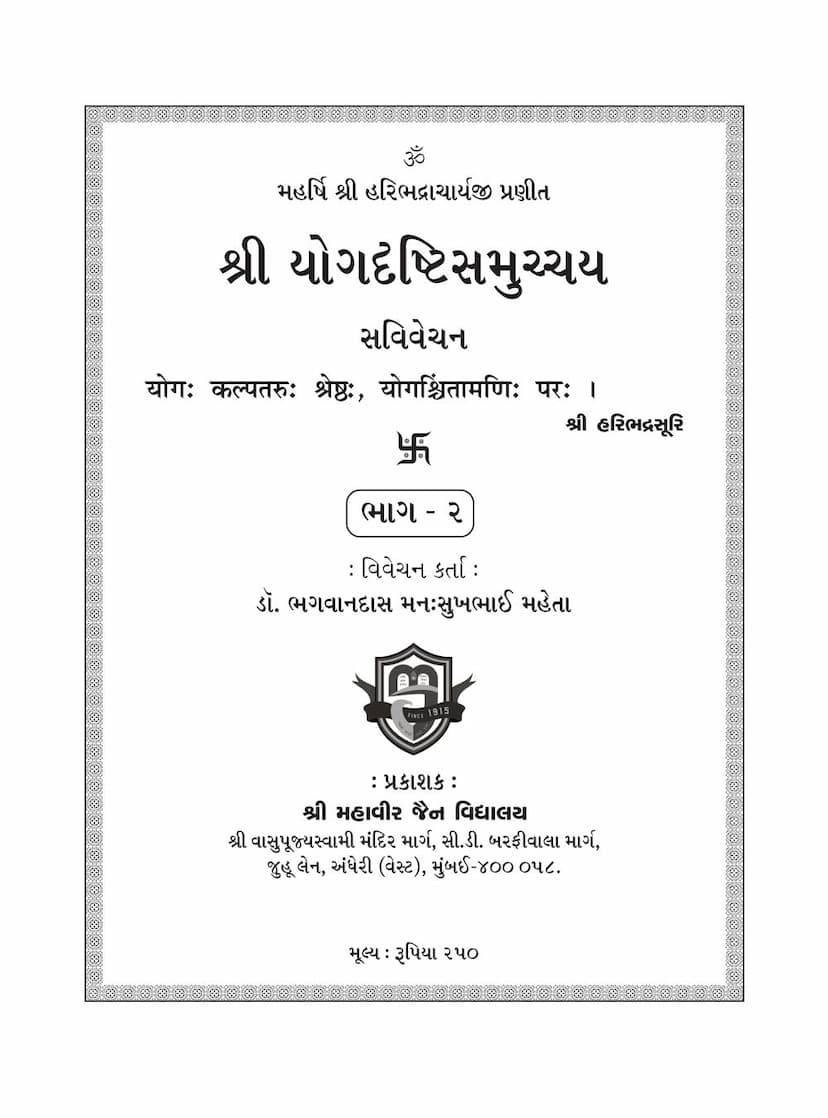Yogdrushti Samucchaya New Edition Part 02
Added to library: September 2, 2025

Summary
Here is a comprehensive summary of the Jain text "Yogdrushti Samucchaya New Edition Part 02" based on the provided pages, focusing on the content related to the text itself and its underlying philosophical and practical aspects within Jainism, as well as the organizational context:
Book Title: Shri Yogadrushti Samucchaya (Shri Yogadrushti Samucchaya) Author: Maharshi Shri Haribhadrasurishwarji (Maharshi Shri Haribhadrasurishwarji) Commentator/Editor: Dr. Bhagvandas Mansukhlal Mehta (Dr. Bhagwandas Mansukhlal Mehta) Publisher: Shri Mahavir Jain Vidyalay, Mumbai (Shri Mahavir Jain Vidyalay, Mumbai)
Overview:
This volume, Part 02 of the "Yogadrushti Samucchaya," is a commentary by Dr. Bhagvandas Mehta on the foundational Jain text authored by Acharya Haribhadrasuri. The text delves into the profound concepts of Yoga and spiritual vision within the Jain philosophy, aiming to guide seekers towards liberation (Moksha). The commentary seeks to make the complex philosophical tenets accessible to practitioners.
Key Aspects Highlighted in the Publisher's Notes and Content:
-
The Text's Significance: The "Yogadrushti Samucchaya" is presented as a paramount work ("shirmoṛ" - the crown jewel) among the many scriptures gifted by the revered Acharyas for the benefit of spiritual seekers. It is considered essential for understanding the progressive path of the soul's development towards Moksha.
-
Commentary's Purpose: The commentary by Dr. Bhagvandas Mehta aims to illuminate the "marm" (essence or core meaning) of the text, making it understandable for the "sadhakvarg" (practitioner class).
-
Publisher's Mission (Shri Mahavir Jain Vidyalay):
- Inspiration: The Vidyalay was founded over 150 years ago (specifically mentioning 100 years prior to 2018, thus around 1914) under the inspiration and blessings of Acharya Vijay Vallabhsuri.
- Goal: The primary goal was to provide educational facilities for students from small towns and cities in Gujarat, who otherwise had to travel to Mumbai for higher studies. The Vidyalay also emphasizes holistic development, integrating intellectual growth with religious values and conduct.
- Core Principles: The institutions established by the Vidyalay adhere to fundamental rules like prohibiting night meals, abstaining from forbidden food (abhakshya), and engaging in religious study alongside spiritual practices.
- Reach and Facilities: The Vidyalay has grown significantly, operating 12 branches with hostels and girls' hostels (chhatralay) in major cities of Gujarat, Maharashtra, and Rajasthan, catering to over 1600 students.
- Financial Aid: It runs an interest-free loan scheme for students pursuing higher professional education, both in India and abroad, to overcome financial barriers.
- Promoting Jain Literature: The Vidyalay actively encourages Jain literature publication through the "Shri Mahavir Jain Vidyalay Jinagam Trust" and publishes extensive research-based and critical literature in simple language. It has also organized 23 Jain literature festivals.
- Endowment: The publication of this particular edition (third edition of Part 02) is supported by the generous contribution of Shri Jain Dharm Pedhi, Shri Shrimali Jain Sangh, Bharuch, inspired by Shri Kanakchandra Shah.
-
Content of Part 02 (Based on the Index): The index provides a detailed breakdown of the topics covered in this volume, which spans from Verse #86 to Verse #228 of the "Yogadrushti Samucchaya." The topics are highly philosophical and practical, covering:
- The Nature of Yoga and Knowledge: Discussing the means to attain transcendental meaning, the futility of mere dry logic (shushk tark) and mere reasoning (anumana) for spiritual realization, and the importance of the teachings of the omniscient (sarvajna).
- Schools of Thought and Their Doctrines: Examining various philosophical viewpoints, including those of Buddha, Kapila, and others, and analyzing the differences and similarities in their teachings.
- The Role of Faith and Practice: Discussing the significance of faith (shraddha), conduct (sheel), concentration (samadhi), and self-effort (purushartha).
- The Path to Liberation: Elaborating on different paths and insights, such as the 'prabhā dṛṣṭi' (radiant vision), 'sthira dṛṣṭi' (stable vision), 'kāntā dṛṣṭi' (pleasant vision), and 'parā dṛṣṭi' (transcendental vision).
- Ethical Principles: Discussing the five restraints (yama) like non-violence (ahimsa) and their application.
- The Ultimate Reality and Its Realization: Exploring the nature of the supreme reality and the means to attain it.
-
Structure and Presentation: The book includes a Mangalacharan (auspicious invocation) by the commentator, followed by the detailed index and the main text with its commentary. The print quality and layout appear to be well-executed, as indicated by the mention of the printer. The price is indicated as ₹250.
In essence, this volume is a scholarly work that aims to provide a deep understanding of the spiritual journey as outlined in Jain philosophy, specifically through the lens of Yoga, with a detailed commentary that clarifies the intricate concepts and practices.